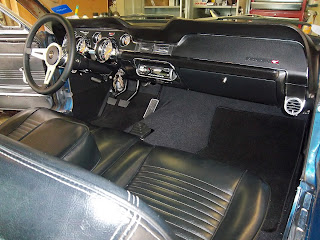After contemplating if I should reinstall the engine or replace the bearings. I searched the Internet and posted questions on a few message boards and about decided to leave it alone. I then decided to go ahead and remove the heads in preparation for the camshaft swap. This would allow me to get them upgraded to screw in studs.
After a week or two, I decided to go ahead and take out the cam. The first few lobes slid from the block with no problem. The cam then stopped and would not come out any further. It took me a second to realize the back side of the first cam bearing was damaged and would not allow the cam to slide out.
I inspected it for a while and strangely, the damage did not impact the cam. It looks like someone was aggressive with installing the distributor and ended up tearing up the cam bearing. In a moment of poor judgement, I used the cam to hammer out the front bearing.... nice, right? Anyway, it came out and did not damage the block or anything else.
Since I was without a cam bearing and worried about the condition of the rest of the motor, I decided I would take the block to have it checked by a Vila's Motor Works. The charge was only $60 for the block and $30 for a set of heads to clean and determine exactly what work was needed to get them into great running condition. I dropped them off on the morning of Monday, October 24th.
On Halloween, I received a call from the machine shop stating the block did not need to be bored and could just be honed and reused. I was glad as I don't know if it could handle a boring to .060 over. The deck did not need any work as it was perfectly flat. The block needed new cam bearings, new crank and rod bearings, and freeze plugs. The only machining needed was to cut the crank .020/.020 under.
I was told the 351 heads would need a large amount of work in order to use them. The guy who worked on them, Mark, was a bit pessimistic about using them with an aftermarket cam. He made a comment more than once when I spoke with him about needing new valves to run aftermarket springs. This made me question his thought process. In the end, I was told the total price to refinish them was $800. I quickly told them I did not want to mess with putting that much money into those heads.
The cost for the block work was $270. I decided I'd go ahead and get different pistons which would allow me to get a higher compression ratio. I purchased a set of Keith Black flat top pistons (KB115), KB moly rings (4000AM8.040), Cloyes Timing Chain (9-1135), and Comp Cams XE256H (31-324-3) cam and lifter set which arrived on November 3rd. I dropped them off the next morning with the 289 heads hoping they could be used at a cheaper rebuild price.
I did not question rebuilding the shortblock for a minute when I heard the cost. However, the cost associated with the job started to hit home when I spent $500 on the parts shown above. Unfortunately, the shop called stating the 289 heads were worse off than the 351 heads as the 289 heads did not have hardened exhaust seats. This is when it really started to snowball out of control.
Last night, I searched for heads on the Internet and started considering options. I thought of going with some GT-40 heads or just some stock style. I could just use the 289 heads as they were working when I pulled them out. However, I know there are at least four leaky valves based on a test I did at home. It would be nice just to have a solid motor and not have to worry about it but all the heads I found were about $300 and they still needed screw in studs, milling, or were just questonable in general.
I started looking at the Edelbrock E-Street heads again. I took a look at them at the GoodGuys meet I went to in March. They are the exact same casting as the Performer and Performer RPM heads. They just have different valves and springs. I found they were on sale at 10% off until today and decided to buy them tonight. I'll now need hardened push rods and roller rockers.... it never ends!
I'll need to have these heads milled a little in order to get to 9:1 compression ratio. If I mill them down about .012, I will have a 58cc combustion chamber and 9:1 compression. This is not outstanding but it is not bad either. If I went further with the milling, each cc I decrease the heads by, I end up with another .1:1 which is not much of a gain. It now occurs to me I probably should have gone with dome pistons but oh well.
As I spent some time cleaning the garage today, I thought about how different it will be to drive the Mustang again. Since I drove it last, I'll install an electric fan, headers, full 2 1/2" exhaust, new pistons, cam, and aluminum heads. I'm sure it will be quite different. I'm ready but I'm thinking I'll need to ask for valve covers and a few other things for Christmas to be able to afford putting it back together.


















































